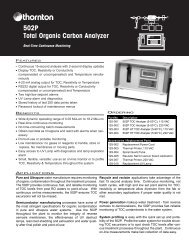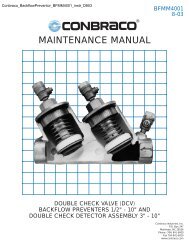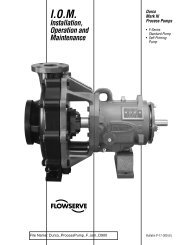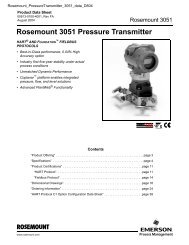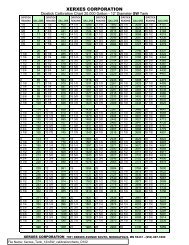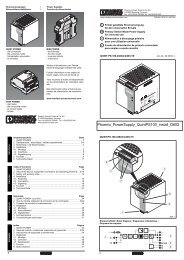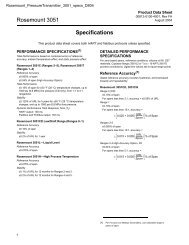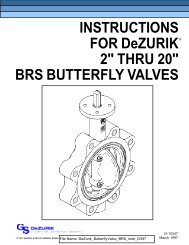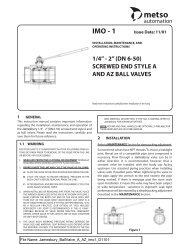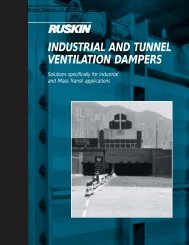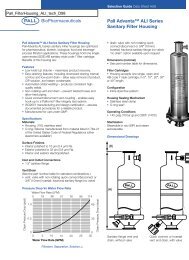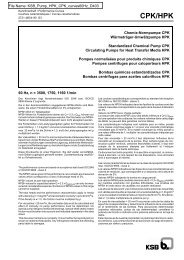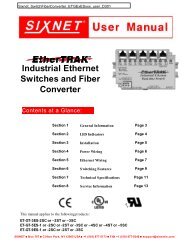USF RO ManualOMRX_6.pdf
USF RO ManualOMRX_6.pdf
USF RO ManualOMRX_6.pdf
You also want an ePaper? Increase the reach of your titles
YUMPU automatically turns print PDFs into web optimized ePapers that Google loves.
RX Manual 04/04 Rev. 6 INT<strong>RO</strong>DUCTION<br />
Customer feedback is also an important element of our program. Division heads meet<br />
on a routine basis to review customer feedback and initiate actions that result in process<br />
and product improvements.<br />
1.3 FUNCTIONS OF THE SYSTEM COMPONENTS<br />
Refer to the Process & Instrumentation Diagram (P&ID) in the Appendix.<br />
A. Low Feed Pressure Switch<br />
A low feed pressure switch protects the high-pressure pump. If the feed<br />
pressure to the pump falls below 15 psig the low feed pressure switch shuts the<br />
system down. The system will automatically restart four more times and if the<br />
low pressure situation has not been corrected after the fifth restart the system will<br />
remain shut down and will not restart until the alarm condition has been<br />
acknowledged and rectified.<br />
B. Reverse Osmosis Pump<br />
The <strong>RO</strong> system pump is a multiple stage centrifugal pump that is close coupled<br />
to an AC motor. The motor is a TEFC design and powered on and off through<br />
the controller by a motor starter.<br />
C. High Membrane Feed Pressure Switch<br />
A high membrane feed pressure switch protects the membranes and <strong>RO</strong><br />
pressure vessels from potentially damaging pressures. If the membrane<br />
pressure exceeds the safe operating pressure for the pressure vessels and/or<br />
membranes, the high-pressure switch shuts the system down and requires<br />
operator intervention prior to restart.<br />
D. Reverse Osmosis Membranes<br />
The prefiltered water enters the <strong>RO</strong> pressure vessel and passes over the surface<br />
of an <strong>RO</strong> membrane. A portion of the feed water continues out of the system<br />
through the reject and reject-recycle needle valves; and is either directed to drain<br />
or just upstream of the pump to increase the feed flow rate. The remainder of the<br />
water permeates the membrane (product) and is directed to an accessory<br />
storage reservoir or point of use. Percent recovery (the ratio of <strong>RO</strong> product water<br />
to feedwater) will vary depending on water quality and the application.<br />
E. Reject / Reject Recirculation Throttle Valves<br />
The flow rates of water exiting the <strong>RO</strong> membranes are controlled by the reject<br />
and reject recirculation valves. Closing the reject valve increases the pressure to<br />
the membranes and reduces the amount of water to drain. Recycling a portion of<br />
the reject water permits part of the total reject flow to be returned upstream of the<br />
pump and can improve <strong>RO</strong> performance and production. Reject recirculation can<br />
be used to increase the overall recovery of the system up to the scaling limit.<br />
F. Product Recirculation Valve<br />
Product recirculation permits excess product water to be returned upstream of<br />
the pump. This function is used when capacity exceeds demand, thus<br />
conserving water and increasing percent rejection (water quality).<br />
<strong>USF</strong>ilter 1-2



